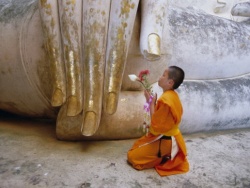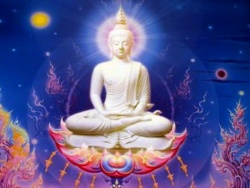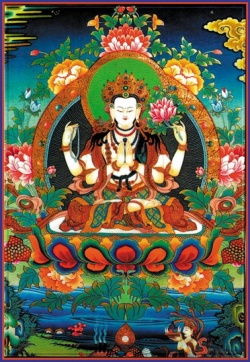Buddhayana
Buddhayana is a term for a more authentic, progressive, tolerant, and inclusive Buddhism. Buddhayana calls on using the wisdom from all the traditions in a syncretic way, but without sacrificing the authenticity of the Dhamma. It typically calls for adaptations to fit with the modern world, which arguably keeps the Dhamma alive since the Buddha gave several teachings on skilful means, abolishing minor training rules if necessary, and adapting to local customs and language. Much of these ideas have since been incorporated in Modern Theravada. The following (below) is adapted from a book by Ven. Shravasti Dhammika:
A revitalized Theravada would be so different from its listless narrow predecessor that it would be only right to call it something else. Another name would also emphasize a conscious desire to evolve new interpretations of the Dhamma rather than just copying or trying to rationalize the old ones. The term theravada itself occurs only once in the Pali Tipitaka where, significantly, it is equated with ‘mere lip service, mere repetition’ (M.I,164).
What name could a new Buddhism go by? The Buddha told his disciples that when others asked what religion they practiced they should say that they were Sakyaputtas, offspring or children of the Sakyan. This is a very endearing name but unfortunately it does not lend itself well to modern usage. On another occasion he called his teachings vibhajjavada, the doctrine of analysis, a name which reflects some aspects of his teachings but not all. Scholars usually describe the teachings in the Pali Tipitaka as primitive Buddhism or early Buddhism. The first of these names conjurs up the image of a monk wearing a bear skin rather than a yellow robe while the second refers only to the Dhamma’s temporal dimension. Navayana, the New Way, is better but would not be entirely correct.
The revitalized Buddhism I envisage would be contemporary in many ways while still drawing most of its inspiration and nourishment from the Buddha, that is, from the past, and so in one sense would not be new. Dhammavada or Buddhavada are perhaps a bit pretentious. For the purposes of these reflections I will use the term Buddhayana, the Buddha’s Way. Such a name would be descriptively accurate, it follows naturally from the names of the earlier expressions of Dhamma – Hinayana, Mahayana and Tantrayana - and it rolls of the tongue well. What would this Buddhism for the 21st century, and hopefully for subsequent ones as well, be like?
Buddhayana would be governed by a properly constituted and legally recognized mahasabha, something like the Board of Governors of the Methodist Church, the Board of Jewish Deputies or perhaps better, the Western Buddhist Order (WBO) and the Friends of the Western Buddhist Order (FWBO). The mahasabha would be a corporate body owning all Buddhayana property and assets and represent it in all matters. The mahasabha would consist of four members – a monk, a nun, a male lay teacher and a female lay teacher who would be elected by local temples, monastic communities and other groups from which they came and they would hold their positions for ten years.
The presidency of the mahasabha would circulate every ten years – a monk one time, a nun next, then a lay man etc. This arrangement would guarantee that the needs and concerns of all members of the Buddhayana community were taken into account and heard and that each would make its own unique contribution to the development of Buddhayana.
For Buddhayana the term Sangha would mean ‘spiritual community.’ Anyone, clerical or lay, who was fully committed to the Dhamma would be considered a member of the Sangha. This accords with a concept already implicit in the suttas where the Buddha says that a monk, nun, lay man or lay woman who is ‘accomplished in wisdom, disciplined, confident, learned, upholding Dhamma and living according to it’ illuminates the Sangha (A.II,8). All monks and nuns would receive a full education in Buddhism, Pali, history of Buddhism, psychology and philosophy before their ordination.
During their education and training they would be instructed in meditation and also be psychologically assessed to see whether they were suited to the monastic life or for the role of being teachers. Academic accomplishments would be important in selecting candidates but personal development would be just as important. Physical disciplines like hatha yoga and tai chi would form an integral part of the training also.
There would be three orders or nikayas within both the monastic and the lay Sangha – a contemplative order, a pastoral order and an academic order. Monastics in this first order would mainly be involved in solitude and self development but would be expected to make some contribution to the community as well - conducting meditation retreats and doing counseling and conflict resolution work. Those in the pastoral order would run local Buddhist centers and receive the appropriate training to equip them for this role.
Monks and nuns of the academic order would be the scholars of the Buddhayana, teaching in universities, doing research work, advising the mahasabha on doctrinal matters, giving the Buddhist perspective on various issues when needed and also acting as dhammadutas both within their own countries and overseas. The monks and nuns of these last two orders would all have a regular meditation practice and also spend at least two months each year in retreat with those from the contemplative order.
Buddhayanist monks and nuns would genuinely renounce on being ordained, giving all their assets to the Sangha and anything they earned or inherited subsequently would also become the property of the Sangha. The Vinaya would govern the behavior of all monastics. Certain rules would be disregarded, just as is done in Theravada, the only difference being which rules were followed and which were not. Buddhayana monks and nuns would abide by the Parajikas as well other rules relevant to monastic living and the modern world.
There would also be a Code of Conduct to cover matters not dealt with by these rules and this would be modified as circumstances required. There would be a body to which complaints about serious breaches of discipline by monastics could be made, it would have the power to investigate such accusations, suggest appropriate punishments and when necessary recommend expulsion from the Sangha.
All monasteries would aim to be self-supporting. Monks and nuns of the contemplative order would run businesses making high quality labor intensive products, operate hospices and conduct retreats. Such enterprises would provide monastics with opportunities for mindfulness in daily life, provide their monasteries with an income and make a contribution to the community. Monks and nuns would normally wear their distinctive and beautiful robes but where necessary or expedient they might don ordinary cloths. They would have common sense enough to know that ‘outward form does not make a monk’ (Dhp.266).
Even when open-minded Theravadins discuss the possibilities of reestablishing the nun’s Sangha the deliberations always seem to revolve around how to reconcile doing this with what the Vinaya says. Such discussions could go on for centuries. Whatever the Buddha said or is supposed to have said, Buddhayanists would believe that it is wrong to exclude woman from the monastic life, that it is inappropriate in the 21st century to require them to always take second place to a male and that it is degrading to treat them as if they had some sort of contagious disease.
They would take as their guide on this and several other issues the Kalama Sutta in which the Buddha says; ‘Do not go by tradition…do not go by the sacred text … But when you yourself know that certain things are right, good, skillful and when followed or practiced results in happiness and benefit, then follow them’ (A.I,188).
If no other solution to the problem could be found the first women candidates to the monastic Sangha would be ordained by monks and all subsequent ones would receive the double ordination. If these women were not accepted as real nuns by traditional Theravadins they would not loose too much sleep over it. In Buddhayana nuns and lay woman teachers would have respect, recognition and opportunity in accordance with their commitment and achievements, just like anyone else.
Being realistic enough to realize that monasticism is never going to be significant in Western society Buddhayana would develop an order of lay teachers similar to Protestant pastors or better, to the Dharmacariyas and Dharmacariyinis of WBO. Some of these might marry, others might choose to remain single.
Many monks and nuns would have been lay teachers before ordaining. At least one forward-looking and thoughtful Sri Lankan monk has already made a move in this direction. Ven. Piyananda of Los Angles has a program of lay training and ordination which has had some success and could well be a model for similar efforts. Lay teachers would run local Buddhist temples or assist monks or nuns in running them and involve themselves in social work.
They would receive an adequate salary from the congregation. Buddhayana lay teachers would be known for their quiet unobtrusive efforts to help others, especially in areas that are strong points of the Dhamma, – relaxation training, counseling, animal welfare, hospice work etc.
Like all responsible citizens, Buddhayana monastics, lay teachers and ordinary followers would have a deep love for their country but this would never blind them to the reality that their main commitment was to the Dhamma, which transcends nationality, race and culture. Knowing full well that the Buddha taught for all humankind they would see themselves as citizens of the world and work for the benefit of all, not just for ‘our people’ or ‘our country.’
As an inviolable principle, no Buddhayanists whether monastic or lay would ever be involved in or seek to justify any form of violence. If required by law to join the army in time of war they would willingly serve as medics, nurses or stretcher-bearers but would never bear arms or fight. Buddhayanists would take the Precepts seriously rather than just recite them mindlessly as is usually done in Theravada. They would never drink or smoke and they would have a strong leaning towards vegetarianism.
Between each other they would retain the anjali (palms together and head slightly bowed) as a graceful and distinctly Buddhist greeting and salutation. When anjalied themselves monks and nuns would always be humble enough and polite enough to return the salutation.
Recognizing that the prevailing interpretations of the Pali Tipitaka has few insights that could be used in its development, Buddhayana should be confident enough of itself to seek nourishment and examples from other sources. To help breath new life into the understanding and practice of meditation it would enter into dialogue with the Ch’an, Zen and Dzogchen traditions, with modern psychology and also perhaps with the teachings of people like Vimala Thakar. Such dialogue is well under way in the West, particularly in the USA, and has already proved fruitful.
Buddhist-Christian dialogue has been going on for some decades but is usually initiated by and directed by Christians themselves and not surprisingly they are the ones who benefit most from it. Nonetheless, there are three areas where dialogue with Christianity might prove useful for an emergent Buddhayana. The first concerns how monasticism might function and survive in the modern world. Catholic monastic orders have declined dramatically in the last forty years but those that survive could be models for how Buddhayana monasteries might function.
A blending of Catholic practicality and the best of the Vinaya might ensure the continuance of the monastic Sangha. The second area where Buddhayana could benefit from Christian input concerns social engagement and practical compassion. What is it in Christianity that has made love so central to the life and practice of its followers?
What is it in Theravada that has retarded this from happening? What aspects of the Buddha’s teachings could be emphasized or reappraised so that a Buddha-like compassion might once more animates and motivate those who live by the Dhamma? Teachers like Thich Nhat Hanh have already begun exploring such issues from the Mahayana perspective but more needs to be done and much could be learned from Christianity.
There is one other area where Buddhayana might be enriched by dialogue with Christians. Theravadian hostility towards all forms of beauty has prevented the development of any sacred music or plainsong beyond the most rudimentary forms. Thai chanting is not unpleasant to the Western ear although its simple tune and rhythm offer limited scope for further development. Burmese and especially Sri Lankan chanting is little more than a caterwaul.
Sonorous music, song and chanting can have an enormous value in communal worship, they can give expression to saddha and they can even be an adjunct to meditation. The Buddhayana would study the rich Christian tradition of plainsong and sacred music and try to develop forms of each that would be suitable to use with Pali gatha and other mediums.
Great emphasis would be given to Dhamma education in Buddhayana. Apart from the normal activities at local temples (Sunday sermons and pujas, Dhamma classes and discussions, group meditations monthly weekend retreats, Sunday School, etc) there would be occasional courses on the more profound aspects of the Dhamma. An accurately translated and readable edition of the Tipitaka would be available in every temple.
However, most people would be familiar on the Cula Tipitaka, a single volume containing a good representative collection of suttas including those relevant to lay people. Both would have the repetitions carefully edited out, a rational and easily usable reference system and a detailed index. To supplement this there would be a multi-volume Encyclopedia of Dhamma comprehensively and authoritatively covering every aspect of the Buddhism.
Both the Cula Tipitaka and the Encyclopedia would be available in every public library in the country. These and other educational resources would be available from the Buddhayana’s own publishing company which, being run by monastics, would be able to produce them at reduced prices.
Buddhayana would have at least two seminaries, one for training monks and male lay teachers and another for nuns and female lay teachers. The education would be liberal, critical, wide-ranging and imbued with the spirit of the Dhamma. Some graduating from these institutions would go on to university to do specialist studies before commencing on their duties.
Another aspect of the Buddhayana’s educational endeavors would be to promote the Dhamma as widely as possible. The Buddha’s exhortation to ‘go forth for the good of the many’ would be taken very seriously. Rationally planned campaigns to promote the Dhamma within specific groups and in certain areas would be a prominent part of Buddhayana activity. All universities would have a Buddhayanist chapel, a chaplain and a study group as would many other institutions.
Declining, weak, or neglected Buddhist communities in Asia – Malay speaking Thais in northern Malaysia, Dalits in India, Tamangs and Newaris in Nepal, Chakmas in Bangladesh etc, would be major beneficiaries of dhammaduta campaigns. Some of these people would be brought to the West for training while Buddhayanists in the West would be specially trained to serve such communities. Together they would work for both the spiritual and material welfare of these people.
The Trailoka Bauddha Mahasangha Sahayak Gana, the Indian branch of the WBO, and the Tzu Chi Foundation of Taiwan would be excellent models for such work. Buddhayana would give special attention to promoting the Dhamma in India, not only because of its enormous potential there but also as an expression of gratitude to the Indian people for giving the world the Buddha.
How would Buddhayana fund itself and its various undertakings and projects? It goes without saying that Buddhayanists would never squander their precious resources on gigantic Buddhas, garish over-decorated temples or lavish ceremonies. In fact they would the severest critics of such embarrassing wastage. Simply not having this drain within the Buddhayana community would mean that there was plenty of money available. Buddhayana would seek to rationalize and modernize the open-handed generosity characteristic of traditional Theravada and this too would be a good source of funds.
Like other charitable organizations, some of its good works would be eligible for government grants while others would attract the generosity of a sympathetic public. The business enterprises run by some monasteries would be highly profitable and the excess after expenses were met would go into a central treasury, although all financial matters would be handled by lay persons.
Likewise, when there was an excess in local temples this would go into this same treasury. This central treasury would be carefully managed and temples, monasteries or groups would submit proposals when they needed funds. When these were approved grants would be made.
Buddhayanists will never be even a large minority within Western societies but their influence will be out of proportion to their numbers. Like Quakers and liberal Jews they would be respected for their liberal and humane outlook, admired for their charitable work and be well-known as progressive and active community leaders.
The best advertisement for Buddhism would be the lives and examples of Buddhayanists themselves. A good number of well educated thoughtful people would see Buddhayana as an attractive alternative to the dogmatism of Christianity or the emptiness of secularism. Far from being just an exotic curiosity Buddhayana would be well integrated into Western society.
Is all this just a pipe dream or could it be actually feasible? Something like what I have called Buddhayana has already been envisaged and brought into being, although not surprisingly, by someone more influenced by Mahayana and Vajrayana than by Theravada. The Western Buddhist Order and the Friends of the Western Buddhist Order were founded in 1967 and now have dozens of centers and thousands of members throughout the West and in India.
The large and flourishing Indian branch of the FWBO is known as the Trilokya Bauddha Mahasangha Sahayaka Gana. There are Buddhist groups in the West which at first glance appear to be firmly established but which are actually dependant on monks from Asia or Western monks trained in Asia, on funds from Asia or from Asian expatriate communities. The WBO has seen the danger of this sort of dependency and has succeeded in being self-supporting and self-sustaining.
The apparent success of some other groups is due to a single charismatic teacher and they quickly go into the doldrums when he or she dies, leaves or falls from grace. The WBO’s initial success was to a large extent due to Sangharashita’s charismatic personality but the main focus has always been on the Dhamma, the benefits of the spiritual life and the attraction of being part of a dynamic and growing community. The WBO runs its own highly successful business enterprises freeing it from a complete dependence on donations and which at the same time provides its members with meaningful work.
The Goenka and the Ajhan Chah movements are centered almost entirely on meditation while the WBO takes a more integrated approach, stressing meditation but also the intellectual, the social and even the economic and aesthetic dimensions of the Dhamma. This not only does justice to the richness of the Buddhist tradition, it gives the WBO a much wider appeal as well. Members of the WBO are almost the only Western Buddhists I ever meet who seem to have an informed view of Buddhism in Asia instead of the usual dreamy idealized one and I suspect that this has had a role in their success too. It has allowed them to see and adopt what is good in the Buddhist tradition and reject what is not, rather than swallowing the whole package.
Historians often say that as Buddhism spread it changed to make itself relevant to the new cultures it encountered. However, this suggests that some sort of agreed upon policy was at work and that the process of adjustment and adaptation was a conscious one, which was certainly not the case. Change took place haphazardly, often unintentionally and sometimes to Buddhism’s detriment One of many examples of this would be the caste systems in Sri Lanka and the Katmandu Valley.
When Buddhism came to these two regions caste was already established but rather than change society, it was Buddhism that changed. Buddhism compromised on its teachings of human equality and dignity and accommodated itself to the institution of caste. Thus even today Sri Lanka’s Siyam Nikaya will only ordain males from the highest caste and Newari Buddhists will not allow people of other castes into their temples.
Sangharashita’s genius was not just that he saw the need for indigenization long before anyone else but that he understood that the process of indigenization had to be conscious and deliberate. He set out to evolve a movement with an organizational structure and an interpretation of the Dhamma that would take into account the realities of Western society without compromising with those aspects of it that were at odds with Dhamma.
Not surprisingly, the result has been highly successful and qualifies Sangharashita to be considered one of the few original Buddhist thinkers of the last three hundred years. It also qualifies him to be considered the first authentic Western Buddhist as opposed to being merely a Westerner who has adopted the Buddhism of Tibet, Japan, Burma or Thailand. This is not to say that the WBO has all the answers but it is an important step in the right direction.
The WBO has not been free from problems either, the most serious of which have been caused by Sangharashita’s somewhat dubious interpretations of several aspects of the Dhamma. But it has shown itself capable of change and more importantly, of critical self-examination - a sophistication entirely absent amongst Asian Buddhists. The WBO proves that a cross-pollination of the best of modern Western thought with the best of ancient Buddhist wisdom can revitalize the Dhamma. What is needed now is more realistic visionaries like Sangharashita.
see also: Buddhayâna; "vehicle of enlightenment" </poem>





